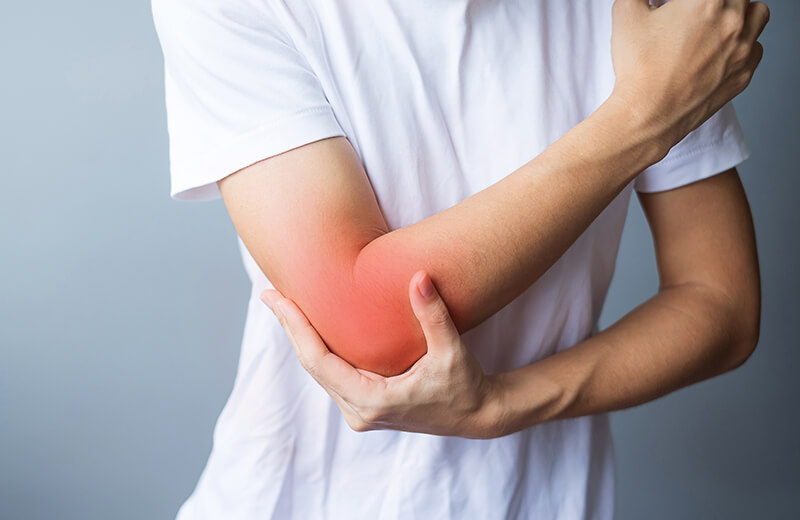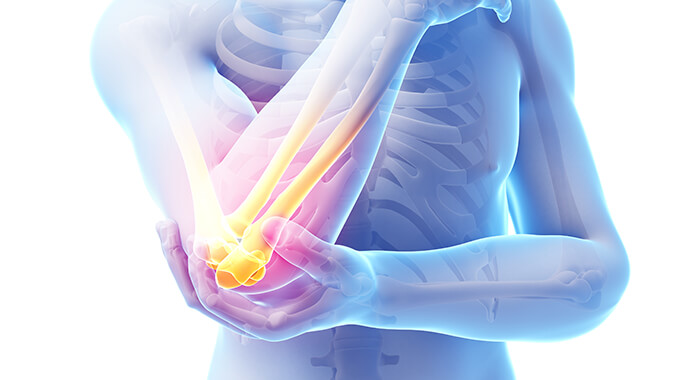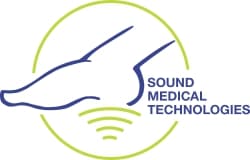ESWT for lateral epicondylitis
Tennis Elbow
An Overview
Extracorporeal Shock Wave Therapy, or ESWT, was first developed in the 1990’s as a treatment for kidney stones. Now researchers have found this treatment effective in treating tennis elbow. When physical therapy, NSAIDS, or rest and ice fail to alleviate this painful condition, doctors have typically used surgery as the next option. However, with ESWT, treatment is applied in only one session, in the doctor’s office, lasting only twenty minutes. Lateral epicondylitis, or “tennis elbow,” is a result of repetitive movements of the forearm muscles.
You don’t need to be a tennis player to suffer from it; tennis elbow is a common workplace or athletic injury. The primary symptom is pain on the outside of the elbow caused by inflammation of ligaments and degeneration of tissue around the joint. This makes twisting movements and lifting objects particularly painful. Tennis elbow usually starts out mild and worsens over time. Chronic sufferers can have disabling pain that rarely relents. Reaching and gripping motions, such as in shaking hands or opening jars, is especially painful. Lifting and carrying even a cup of coffee or gallon of milk are also painful for the person affected with this condition.
What Are Causes Of Tennis Elbow?
If you are suffering from tennis elbow then you don’t have to investigate too much for its cause since, only repetitive strenuous activity is the main cause of tennis elbow.
When this happens you may develop some tears and experience inflammation in your elbow.
Tennis elbow usually appears when you suddenly do an activity you never did, your elbows aren’t used to that activity or if you use your forearm muscle too frequently.
What Activities Have Higher Risk Of Tennis Elbow?
Any activity that forces you to use your elbow repetitively can cause you tennis elbow, some activities that can make this more happen to you include:
- Using gardening tools often
- Playing games like tennis and badminton too much, you should take rest after playing
- Excess typing or using mouse can also cause this problem
- Playing violin may also cause problems since it’s a repetitive activity


Signs and symptoms:
- Inability to extend the forearm fully without discomfort.
- Pain caused by lifting, bending the arm or grasping even light objects.
- Trigger point elbow tenderness.
- Recurring pain on the outside of the upper forearm just below the bend of the elbow.
- Pain that radiates down the arm toward the wrist.
- Pain when shaking hands, turning door knobs, or lifting a grocery bag.
- Muscle weakness in shoulder, forearm, and wrist.
- Occasional muscle spasms in lower arm.
Treatment with ESWT
During the session, you comfortably recline while the elbow is placed on a warm water bubble and covered with gel. The injured area is viewed with diagnostic ultrasound. Then, we then deliver tiny little pressure waves or “shockwaves” to the injured area. Healing occurs gradually over the next 6-12 weeks. Approved by the National Institute for Clinical Excellence for use on tennis elbow one year ago, we are happy to make this treatment available to you. Call our office today to begin experiencing the relief this treatment offers in one short session.
Is Tennis Elbow Preventable?
Yes, you can easily prevent this elbow pain without any kind of problem since all you need to do is avoid the activity that causes you this pain!
However, only one tip isn’t enough, therefore here are some more tips to help you prevent tennis elbow:
- Use lightweight tools for gardening or any other work
- If any activity causes pain then stop doing it right away or try to find another way to do it.
- Try to increase the strength if your forearm and elbow, some exercises can help you achieve this
- Receive advices from your coach, this may help you get to know about right technique.
- Before starting any repetitive activity do not forget to warm up properly and take a proper rest after you are done.
- Apply ice to your elbow or forearm after the activity, or you can apply heat too
- Change height of your keyboard and mouse

Tennis Elbow FAQs
What is tennis elbow?
Tennis elbow is technically known as lateral epicondylitis. It’s chronic, painful condition which affects the outside of the elbow. Usually it’s felt as a sharp, often severe elbow pain just below the elbow joint, especially with movements of the forearm, elbow, and hand. Even without movement, patients often feel an achy pain, again sometimes severe. Lateral epicondylitis is an overuse injury, a type of injury that often takes years to develop, and tends to get progressively worse without treatment—other common overuse injuries include plantar fasciitis, carpal tunnel syndrome, and various types of bursitis. This is an extremely common elbow injury. Note that chronic pain on the outside of the elbow, especially with use, is called golfer’s elbow, or medial epicondylitis.
Causes
An overuse and muscle strain injury is tennis elbow. The muscles in your forearm that you repeatedly contract in order to straighten and raise your hand and wrist are to blame. The tendons that connect the forearm muscles to the bony prominence at the outside of your elbow may experience a series of microscopic rips as a result of the repetitive motions and tissue stress.
Tennis, as the name suggests, is a sport that can result in tennis elbow, particularly when the backhand stroke is used repeatedly and improperly. Tennis elbow, however, can also result from numerous other regular arm movements, such as:
- Using tools for plumbing
- Painting
- Putting screws in
- chopping up meat and other ingredients for cooking
- use of the computer mouse repeatedly
Are there any complications associated with untreated or poorly managed tennis elbow?
Yes, untreated or poorly managed tennis elbow can lead to several complications. Some potential complications associated with tennis elbow include:
- Chronic Pain:
If tennis elbow is left untreated or not properly managed, the pain can become chronic and persistent, significantly affecting daily activities and quality of life.
- Limited Functionality:
The pain and inflammation from tennis elbow can restrict the movement of the affected arm and weaken the grip strength, leading to limitations in performing tasks that require gripping or lifting.
- Tendon Rupture:
In severe cases or if the condition is left untreated for an extended period, there is a risk of partial or complete rupture of the affected tendon, which may require surgical intervention to repair.
- Reduced Range of Motion:
Long-standing tennis elbow can result in stiffness and reduced range of motion in the elbow joint, affecting the flexibility and mobility of the arm.
- Muscle Atrophy:
Prolonged pain and limited use of the affected arm can lead to muscle atrophy, causing a loss of muscle mass and strength in the forearm and surrounding areas.
- Decreased Performance in Sports and Activities:
For individuals involved in sports or activities that require repetitive arm movements, untreated tennis elbow can hinder performance and prevent participation.
How long does it typically take to recover from tennis elbow?
The recovery time for tennis elbow can vary significantly, ranging from a few weeks to several months. It depends on factors such as the severity of the condition, individual healing abilities, adherence to treatment protocols, and any underlying contributing factors. With appropriate rest, modifications to activities, and adherence to recommended treatments like physical therapy, stretching exercises, and anti-inflammatory measures, many individuals experience improvement within a few weeks. However, full recovery may take several months for some cases.
What are symptoms of tennis elbow? How does it feel?
Here are the most common symptoms of tennis elbow. Remember that there can be other symptoms, so be sure to talk to our doctors at Sound Medical in Pittsburgh.
A sharp, achy, or burning pain on the outside of the elbow, usually just below the joint, especially when moving the elbow. Movements and activities which trigger this include: picking up objects, bending the elbow either way (elbow flexion and extension, making a fist, bending the wrist, or using the muscles of the forearm. Even simple actions like shaking hands or picking up grocery bags can cause extreme tennis elbow pain.
A duller, achy pain in this same area. It is sometimes constant.
Forearm pain radiating from the side of the upper part of the forearm all the way to the wrist—especially with movement (using the forearm muscles). Tennis elbow is a common forearm injury.
A tender “trigger point” in the muscles just below the elbow joint. This will hurt more when the patient presses on it.
Weakness of the muscles in the wrist, the forearm, or even the shoulder. Forearm muscle weakness is a common symptom of tennis elbow in Cranberry patients.
Muscle spasms anywhere along the affected arm.
Can tennis elbow be prevented, especially for individuals who engage in repetitive activities?
While it might not always be possible to prevent tennis elbow, especially for individuals with repetitive activities, there are several strategies that can help reduce the risk of developing this condition:
1. Proper Technique: If your activities involve repetitive motions, ensure you are using proper techniques and equipment. For example, athletes should use the correct grip size and string tension for their tennis racket.
2. Warm Up and Stretching: Warm up your muscles before engaging in any repetitive activity. Stretching the forearm muscles can be particularly helpful. Consult a physiotherapist for appropriate stretches.
3. Strengthening Exercises: Strengthening the forearm muscles can help provide better support to the tendons. Work with a fitness or healthcare professional to develop a suitable strengthening routine.
How long does it typically take to recover from tennis elbow with proper treatment?
The recovery time for tennis elbow (lateral epicondylitis) can vary significantly from person to person and depends on several factors, including the severity of the condition, the effectiveness of the chosen treatments, and how well the individual follows the recommended rehabilitation and rest protocols. With proper and timely treatment, many people experience improvement within a few weeks to a couple of months. However, for more severe or chronic cases, the recovery process can take several months. Here is a general timeline for recovery based on the effectiveness of the treatment:
1. Moderate Cases: Cases with moderate pain and inflammation might require a combination of treatments, including rest, physical therapy, anti-inflammatory medications, and possibly braces. Recovery for moderate cases can take anywhere from 3 to 6 months.
2. Severe or Chronic Cases: Severe or chronic cases of tennis elbow might require more intensive treatments such as corticosteroid injections, shockwave therapy, or in rare cases, surgery. Recovery for severe cases can take several months to a year, and in some cases, ongoing management might be necessary.
Is it safe to continue playing tennis or participating in other sports while recovering from tennis elbow?
Whether it’s safe to continue playing tennis or participating in other sports while recovering from tennis elbow depends on the severity of the condition and the recommendations of a healthcare professional. In general, it’s essential to listen to your body and avoid activities that exacerbate pain or discomfort in the affected elbow.
Here are some considerations to keep in mind:
- Consult with a Healthcare Professional: Before returning to sports or other physical activities, it’s important to consult with a healthcare professional, such as a doctor or physical therapist, who can evaluate the severity of your tennis elbow and provide personalized recommendations for recovery and activity modification.
- Modify Activities: In many cases, individuals with tennis elbow can continue participating in sports and other physical activities with modifications to reduce strain on the affected elbow. This may involve adjusting technique, using equipment with proper grip size and shock absorption, or incorporating rest periods into activity sessions.
What To Do If Conservative Treatments Don’t Work On Tennis Elbow?
If you are suffering from tennis elbow and conservative or home remedies fail to work, you should consider trying out more advanced options, which can include:
- Physical Therapy: Special exercises and stretches are great for strengthening muscles and improve flexibility.
- Medicines: Anti-inflammatory medications or corticosteroid injections can provide relief but it’s temporary only.
- Platelet-rich Plasma Therapy (PRP): PRP is a method that involves injecting a concentration of platelets from your own blood into your elbow to promote the healing process. And since they are your own platelets, there are no risks of rejection which makes this process easier.
- Surgery: If your condition is serious, a surgical treatment may be needed to remove degenerated tissues or repair damage to tendons. This should be considered your go-to option if nothing else has worked so far.
How Will Tennis Elbow Affect Daily Activities And Quality Of Life?
Tennis elbow can significantly affect your daily activities and quality of life in multiple ways, here’s how:
- Pain and Discomfort: Even if you take pain relievers, the relief from pain will be temporary, and until you don’t get it’s treatment, you will suffer from pain and discomfort which can make many simple daily activities hard and cause stress, frustration and irritation.
- Reduced Strength And Flexibility: Weakness and limited range of motion in the elbow will hinder activities that require strength from arm. Carrying groceries, playing sports, or performing chores can become harder and painful.
- Sleep Disruption: Pain may get worse at night, if you accidentally put pressure on your elbow during night, it can disturb your sleep and cause long lasting pain that makes sleeping much harder.
- Difficulty in work: If your work requires use of arm, such as lifting or heavy work, then you may be in trouble!
How long does it typically take to recover from tennis elbow?
The recovery time for tennis elbow can vary depending on several factors, including the severity of the condition, individual response to treatment, and adherence to rehabilitation protocols. In general, mild cases of tennis elbow may resolve with conservative treatment within a few weeks to a couple of months, while more severe or chronic cases may take longer to heal.
Here’s a general timeline for recovery from tennis elbow:
- Initial Relief of Symptoms: With proper rest, activity modification, and conservative treatments such as ice, over-the-counter pain medications, and topical analgesics, individuals with tennis elbow may experience initial relief of symptoms within a few days to a week.
- Progressive Improvement: As individuals with tennis elbow continue with their rehabilitation program, they should experience progressive improvement in symptoms, including reduced pain and improved strength and flexibility in the affected arm.
What are the potential complications of untreated tennis elbow?
Untreated tennis elbow can lead to several complications, which may worsen over time and affect daily activities. Here are some potential complications:
1. Chronic Pain: Persistent pain that may become more severe and constant over time.
2. Decreased Range of Motion: Reduced flexibility and movement in the elbow, making it difficult to perform everyday tasks.
3. Loss of Strength: Weakening of the forearm muscles, leading to a decrease in grip strength.
4. Reduced Functionality: Difficulty performing tasks that require repetitive hand, wrist, or elbow movements, such as lifting, gripping, or typing.
How Age Or Lifestyle Impacts The Likelihood Of Developing Tennis Elbow?
Here’s how age and lifestyle makes tennis elbow more likely:
1. Age:
• People aged 30-50 are at a high risk of Tennis elbows, because at this stage tendons tend to get weaker and recover much more slowly.
2. Lifestyle:
• Repetitive Movements: Activities that require a lot of movement of elbow can stress on the arm tendons, this can include jobs like typing, painting or some sports like tennis or golf.
• Sedentary Life: Inactivity can make muscles weaker, which makes them much more prone to injuries
• Heavy Work: As if it’s already not obvious, lifting or gripping heavy objects repeatedly can strain your tendons and make them weaker.
• Smoking and Poor Diet: They are already known for slow healing, which means continuing them will lead to slowing down the tendon healing.
Prevention:
• Try regularly exercises that keeps your tendons strong!
• Take breaks from repetitive tasks.
• Be careful and use proper techniques for work and sports.
What Activities Should I Avoid To Make Sure Worsening Of Tennis Elbow?
To make sure you prevent the worsening of tennis elbow, make you avoid activities that strain the affected area and muscles, here what you must avoid in detail:
1. Repetitive Motions:
• Typing, painting, or using a mouse without proper wrist support
• Lifting, gripping, or twisting repetitively
2. Overuse of the Forearm Muscles:
• Playing any sport with racquets with poor techniques or equipment this can include sports like tennis and squash.
Heavy Lifting:
• Do not lift heavy objects with your palm facing down
• Avoid carrying heavy bags with arm that’s damaged
Will There Be Long-term Complications If Tennis Elbow If It’s Left Untreated?
Yes, Tennis elbow is no joke, if it has been kept untreated for a long term, it can lead to problems like chronic pain, reduced arm strength, and limited range of motion eventually. Overtime, the strain will start causing tendon degeneration which makes the treatment and recovery much more difficult.
Are there specific exercises or stretches that can help with tennis elbow?
Yes, specific exercises and stretches can help manage and alleviate the symptoms of tennis elbow by strengthening the forearm muscles and improving flexibility. Here are some recommended exercises and stretches:
Stretches
1. Wrist Extensor Stretch:
– Extend your arm in front of you with your palm facing down.
– Use your other hand to gently bend your wrist downward until you feel a stretch on the top of your forearm.
– Hold for 15-30 seconds and repeat 3 times.
2. Wrist Flexor Stretch:
– Extend your arm in front of you with your palm facing up.
– Use your other hand to gently bend your wrist downward until you feel a stretch on the underside of your forearm.
– Hold for 15-30 seconds and repeat 3 times.
3. Towel Twist:
– Hold a towel with both hands and twist it as if wringing out water.
– Twist in both directions (inward and outward) to stretch and strengthen the muscles.
– Perform 10 twists in each direction.
Strengthening Exercises
4. Wrist Curls:
– Sit with your forearm resting on a table or your thigh, palm facing up.
– Hold a light dumbbell or a can of soup.
PRP for tennis elbow
While ESWT is the Gold Standard and best noninvasive treatment for tennis elbow, new research has been done with the use of PRP for this condition.
A PRP treatment involves a series of injections directly into damaged tissue. As mentioned, platelets are covered in naturally occurring chemicals vital to this healing response. It is this characteristic that Regenerative Medicine relies upon when using PRP to treat chronic musculoskeletal conditions. The injections trigger a powerful healing response which can last for weeks or months. Often this is enough to force the body to finish incomplete or poor-quality healing. Tennis elbow, or lateral epicondylitis, is a great example. It’s a very common condition which can persist for years through varying cycles of flare-ups and die-downs. The underlying problem is the accumulation of small amounts of damage in the ligaments of the elbow. After some time, the ligaments are in a constant state of inflammation and the patient begins to experience pain.

